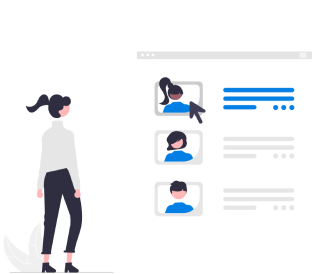Intersectionality Definition
Intersectionality is a framework recognizing that individuals hold multiple, overlapping identities, including race, gender, sexuality, disability, class, and religion that simultaneously shape experiences and opportunities. Unlike analyzing each identity separately, intersectionality theory examines how these interconnected identities create unique combinations of advantage and disadvantage.
Intersectional identity acknowledges that a woman of color experiences workplace dynamics differently than a white woman, not simply as 'woman' plus 'person of color,' but as a complex intersection creating distinct experiences. Intersectional analysis at work exposes how systems of power intersect to create compounded discrimination or privilege affecting employee experiences differently based on identity combinations.
What are Examples of Intersectionality at Work?
Intersectionality manifests through multiple workplace scenarios illustrating how combined identities create unique experiences.
Workplace Intersectionality Examples
A Black woman in tech faces gender divide in male-dominated fields plus racial bias, creating compounded barriers to advancement. Her intersectional identity experience differs fundamentally from white male, white female, or Black male colleagues. A gay man with a disability navigates both sexual orientation discrimination and disability-related accessibility gaps simultaneously.
A woman from a lower socioeconomic background navigates class-based assumptions about competence while managing gender-based expectations. Immigrant women encounter language barriers, cultural differences, gender dynamics, and potential immigration status discrimination interacting together. LGBTQ+ individuals from religious communities experience unique tensions between identity expression and cultural/family expectations affecting workplace authenticity.
Intersectional analysis reveals these employees require tailored support, not one-size-fits-all inclusion initiatives. Understanding intersectionality at work enables organizations designing policies addressing specific, overlapping barriers.
How Does Intersectionality Affect Employee Experience?
Intersectionality fundamentally shapes employee experiences, affecting belonging, advancement, and career satisfaction. Employees with multiple marginalized identities report lower belonging, higher stress, and reduced psychological safety than employees with fewer marginalized identities.
Impact on Workplace Belonging and Advancement
Employees experiencing intersectional discrimination face compounded barriers to leadership roles. A lesbian woman of color encounters combined gender and racial biases affecting promotions, mentorship, and evaluations. Intersectional disadvantage is non-linear—a transgender woman of color experiences different barriers than cisgender women of color or transgender white women.
Barriers to Mentorship and Sponsorship
Employees from marginalized backgrounds often lack mentors sharing their intersectional identities. Senior leaders unconsciously mentor employees resembling themselves, perpetuating homogeneous leadership pipelines. Formal mentorship programs pairing diverse employees with senior leaders address these gaps, enabling equitable development.
Psychological Safety and Code-Switching
Multiply marginalized employees expend emotional energy navigating workplace dynamics and moderating self-expression. Code-switching modifies behavior and communication based on context—increases stress, reduces engagement, and contributes to burnout. Organizations must create cultures where employees feel safe bringing authentic selves to work.
Compensation and Advancement Disparities
Intersectional discrimination creates measurable earnings gaps invisible in aggregate diversity data. Women of color earn less than white women; LGBTQ+ people of color experience different gaps than cisgender LGBTQ+ employees. Using HR technology platforms to track advancement and compensation across intersectional combinations reveals disparities, enabling targeted interventions.
Performance Evaluation Bias
Performance evaluations reflect intersectional biases affecting career trajectories. Women of color receive feedback emphasizing personality over competence; LGBTQ+ employees face assumptions about commitment based on identity. Structured evaluation processes and bias training reduce disparities, ensuring fair assessment regardless of identity.
Difference Between Feminism and Intersectionality
| Aspect | Feminism | Intersectionality |
|---|---|---|
| Core Definition | Advocates for gender equality, traditionally focusing on women's rights and opportunities. | Examines how overlapping identities (race, gender, class, sexuality, disability, etc.) create interconnected systems of advantage and disadvantage. |
| Historical Focus | Early feminism primarily centered on the experiences of white, middle-class women. | Emerged from Black feminism as a critique of mainstream feminism's exclusions. |
| Scope of Concern | Focuses specifically on gender equality and women's empowerment. | Addresses multiple dimensions of identity and how they intersect to shape individual experiences. |
| Inclusivity | Initially limited, often marginalizing women of color, LGBTQ+ women, disabled women, and working-class women. | Promotes inclusivity by recognizing and valuing the diverse experiences of all women and marginalized groups. |
| Theoretical Evolution | Feminism evolved over time to include various waves and perspectives addressing different gender issues. | Originated within feminist theory but expanded into a broader analytical framework applicable across disciplines. |
| Key Contribution | Advocated for women's rights and gender-based reforms. | Enriches feminist thought by ensuring gender equity initiatives benefit all women, especially those with intersecting marginalized identities. |
Why Should Leaders Consider Intersectionality Framework?
Organizations adopting intersectionality frameworks create genuinely inclusive workplaces addressing experiences of employees across all identity combinations.
Business and Ethical Imperatives
Intersectionality framework prevents well-intentioned inclusion initiatives from inadvertently excluding employees with multiple marginalized identities. Leaders implementing diversity and inclusion strategies through intersectional lenses design policies benefiting all employees equitably.
Intersectional analysis reveals hidden disparities in compensation, advancement, and opportunity distribution invisible in aggregate diversity metrics. Leaders utilizing HR analytics capabilities examining intersectional combinations identify specific employee groups experiencing barriers, enabling targeted interventions.
Organizations embracing intersectionality framework attract diverse talent seeking genuinely inclusive environments. Employee engagement increases when policies acknowledge and address intersectional experiences. Implementing talent development programs considering intersectionality builds stronger, more innovative teams leveraging diverse perspectives.
Create workplaces where all identities thrive through intersectionality frameworks. Qandle's HR platform supports equitable policies, inclusive hiring, and targeted development across all employee experiences. Book your free 14-day trial now.


 Back to Glossary
Back to Glossary